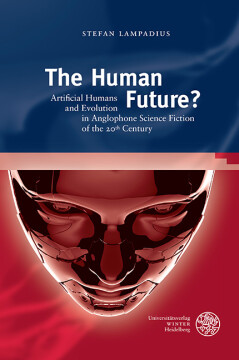
BUCH
The Human Future?
Artificial Humans and Evolution in Anglophone Science Fiction of the 20th Century
Anglistische Forschungen, Bd. 469
2020
Zusätzliche Informationen
Bibliografische Daten
Abstract
This study investigates the artificial human as a central motif in Anglophone science fiction of the 20th century. It explores how robots, cyborgs, androids, clones and digital subjects are represented as constitutive parts of the human future within the modern metanarrative of evolution, ranging from utopian hopes for greater human agency to dystopian fears of unprecedented determinism. This book discusses the artificial human as a focal point for multiple, intersecting discourses on human identity in relation to fundamental 20th-century developments. The analysis of a representative selection of novels, short stories and plays sets out to unravel the complex visions of future humanity at the intersection of literature and science. The study demonstrates how an evolutionary perspective serves to dramatize the human condition, from early stories of bioengineering and machine ethics to narratives of postmodern cyborgisation and a posthuman digital humanity.
Inhaltsverzeichnis
| Zwischenüberschrift | Seite | Aktion | Preis |
|---|---|---|---|
| Cover | Cover | ||
| Titel | III | ||
| Imprint | IV | ||
| Contents | V | ||
| Acknowledgements | VII | ||
| Abbreviations Used | IX | ||
| 1 Introduction | 1 | ||
| 2 Science Fiction, Creation and Evolution | 15 | ||
| 2.1 The Science Fiction Genre | 15 | ||
| 2.2 From Creation to Evolution | 20 | ||
| 2.3 H. G. Wells and Artificial Evolution | 27 | ||
| 3 The Artificial Future – From H. G. Wells to Olaf Stapledon | 37 | ||
| 3.1 Introduction | 37 | ||
| 3.2 The Robots Are Coming – Karel Čapek’s ‚R.U.R.‘ (1920) | 45 | ||
| 3.3 ‘Creative Evolution’ and Science as Art – G. B. Shaw’s ‚Back to Methuselah‘ (1921) | 58 | ||
| 3.4 The Epic Myth of Evolution – Olaf Stapledon’s ‚Last and First Men‘ (1930) | 72 | ||
| 4 The Price of Utopia – Aldous Huxley’s ‚Brave New World‘ (1932) | 93 | ||
| 4.1 Introduction | 93 | ||
| 4.2 Life from the Laboratory and the Artificial Baby | 97 | ||
| 4.3 The World State as Superhuman Organism | 103 | ||
| 4.4 Fordist Mass Production and the Perfect Consumer | 112 | ||
| 4.5 John the Savage as the ‘Missing Link’ | 120 | ||
| 4.6 Conclusion and Outlook | 127 | ||
| 5 The Ethical Machine – Isaac Asimov’s ‚I, Robot‘ (1950) and its Legacy | 131 | ||
| 5.1 Introduction | 131 | ||
| 5.2 The Three Laws of Robotics | 133 | ||
| 5.3 Robot Emancipation | 139 | ||
| 5.4 Playing the Evolutionary Game | 146 | ||
| 5.5 Jack Williamson – ‚The Humanoids‘ (1949) | 151 | ||
| 5.6 Conclusion and Outlook | 157 | ||
| 6 The Artificial Double – Philip K. Dick’s ‚Do Androids Dream of Electric Sheep?‘ (1968) | 161 | ||
| 6.1 Introduction | 161 | ||
| 6.2 Artificial Animals and the Reconstruction of Nature | 165 | ||
| 6.3 Empathy and Being Human(e) | 172 | ||
| 6.4 Uncanny Doubles and Reality as a Construct | 182 | ||
| 6.5 Conclusion and Outlook | 194 | ||
| 7 The Cybernetic Revolution – William Gibson’s ‚Neuromancer‘ (1984) | 197 | ||
| 7.1 Introduction | 197 | ||
| 7.2 From Cybernetics to Cyberpunk | 204 | ||
| 7.3 Evolution of the Cyborg | 215 | ||
| 7.4 Cyborgisation between Utility and Art | 226 | ||
| 7.5 Cyberspace as a New Human Environment | 232 | ||
| 7.6 Artificial Intelligence as Evolving, Human-like Species | 244 | ||
| 7.7 Conclusion and Outlook | 256 | ||
| 8 Digital Humanity – Greg Egan’s ‚Diaspora‘ (1997) | 259 | ||
| 8.1 Introduction | 259 | ||
| 8.2 Digital Genesis and the Language of Evolution | 263 | ||
| 8.3 Gender and Politics of the Body | 273 | ||
| 8.4 Evolutionary Space and New Dimensions of Life | 290 | ||
| 8.5 Conclusion | 309 | ||
| 9 Conclusion and Outlook | 311 | ||
| Works Cited | 321 | ||
| Backcover | Backcover |


 Publishing Platform by CloudPublish
Publishing Platform by CloudPublish